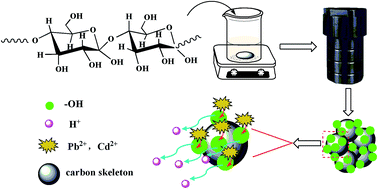Cost effective biochar gels with super capabilities for heavy metal removal†
Abstract
A novel material, the biochar of a konjac-based material (KGMB), was prepared conveniently and economically with chemical activation of hydrothermally synthesized carbon nanospheres. Those carbon nanospheres have small sizes and high surface areas due to the high temperature sintering, which could be used for efficient adsorption of heavy metal ions such as Pb2+ and Cd2+. Detailed adsorption behaviors of the optimized biochar including adsorption isotherms and adsorption kinetics were investigated. The results indicated that the adsorption process is spontaneous, exothermic and pseudo-second-order chemisorption. When the temperature was 298 K, the KGMB dose was 5 mg, the initial concentration of Pb2+ and Cd2+ was both 50 mg L−1, the contact time was 24 h and pH of the ion solution was 5.5, the adsorption capacity reached up to 186.56 mg g−1 for Pb2+ and 129.67 mg g−1 for Cd2+, respectively. What's more, the adsorption capacities of Pb2+ and Cd2+ were 69.34 and 71.06 mg g−1, respectively, after adsorption–desorption process happened three times. Comparisons of the adsorption capacity of various adsorbents for Pb2+ and Cd2+, showed that this biochar is superior to many other adsorbents in terms of adsorption capacity and it is a cheap, efficient and accessible biochar. Thus, KGMB is a promising candidate for wastewater treatment.



 Please wait while we load your content...
Please wait while we load your content...